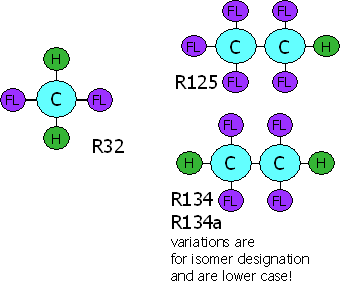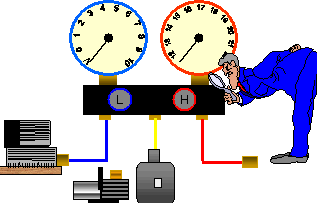R407C does not contain the chlorine, necessary for the dissolving of mineral oils, used with R22. It has therefore been necessary to develop oils, which are compatible with the new refrigerants. They are known as Polyolester or POE oils. They are considered to be superior oils, less liable to breakdown however they are more hygroscopic – they must therefore be kept from contact with air as far as is practical.

Unlike R22, R407C is a mixture of three refrigerants, which boil at different temperatures. R407C has a range or glide of approximately 5ºC.
What will change?
For the Specifier, very little apart from access to jobs requiring a refrigerant that does not contain chlorine.The engineer will find a few changes though.
Clean installation practices, effective leak testing and de-hydration and the weighing of additional refrigerant requirements remain vital. But all of these procedures have long been associated with R22 and indeed any other refrigerants.
Both oil and refrigerant will absorb moisture more readily however the working practices will still dictate that pipework is capped wherever possible and that the system is effectively de-hydrated.
Concerns have been expressed that a moderate loss of refrigerant will now require the entire charge to be removed, before the system can be pressure tested, repaired, and fully re-charged. In short, systems will no longer be able to be topped up. Once again, this is no different to the procedures required with R22 but supports the case for ensuring that the system is leak free at installation.
Extensive tests have been undertaken and consistently conclude that the refrigerant left in a system following a wide range of leaks is not significantly changed in composition.
It will however be necessary to add R407C as a liquid, to ensure that the correct mix is added.
R407C and R22 compared
Differences between R22 and R407C

In operation, R407C provides a number of indications that, if applied to R22 would indicate that the system were overcharged. Although slight, the following changes may be anticipated:
Higher head pressure
Lower compressor superheat
Lower refrigerant temperature difference across the condenser.
Also there may be frosting at the evaporator inlet.

Equipment
All equipment used with the new refrigerant and oil must be compatible.
1. Vacuum pump should be compatible however provided that oil is regularly changed it can be universal.
2. Leak testers that rely on a reaction with chlorine (i.e. halide) will not work with R407C.
3. Gauges should be universal however do provide a means of contamination between oil types. Purge and blow through with OFN if in doubt.
4. Reclaim unit – dedicated to refrigerant.